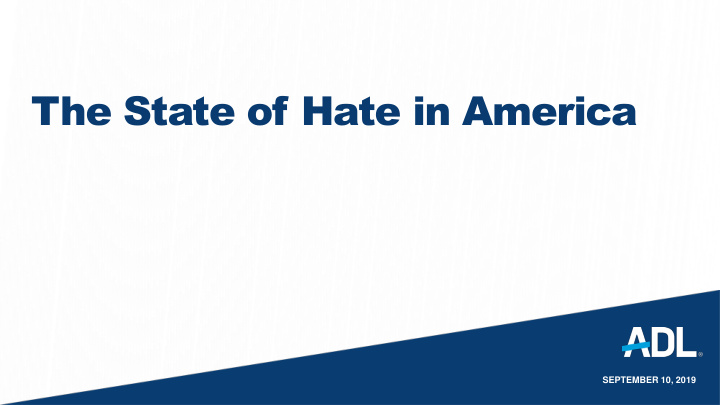



The State of Hate in America SEPTEMBER 10, 2019
14 WORDS 2 We must secure the existence of our people and a future for white children.
3
Our Backyard 4
5
6
7
8
The State of American White Supremacy 9 White supremacists in the U.S. have experienced a resurgence in the past three years, driven in large part by the rise of the alt right. Summary: The white supremacist “Unite the Right” rally in Charlottesville, Virginia, on August 11 -12, 2017, attracted some 600 extremists from around the country and ended in deadly violence. These shocking events served as a wake-up call for many Americans about a resurgent white supremacist movement in the United States. Modern white supremacist ideology is centered on the assertion that the white race is in danger of extinction, drowned by a rising tide of non-white people who are controlled and manipulated by Jews. White supremacists believe that almost any action is justified if it will help “save” the white race.
The State of American White Supremacy (continued) 10 The white supremacist resurgence is driven in large part by the rise of the alt right, the newest segment of the white supremacist movement. Youth-oriented and overwhelmingly male, the alt right has provided new energy to the movement, but has also been a destabilizing force, much as racist skinheads were to the movement in the 1980s and early 1990s. The alt right has a white supremacist ideology heavily influenced by a number of sources, including paleoconservatism, neo-Nazism and fascism, identitarianism, renegade conservatives and right-wing conspiracy theorists. The alt right also possesses its own distinct subculture, derived especially from the misogynists of the so- called “manosphere” and from online discussion forums such as 4chan, 8chan and Reddit.
The State of American White Supremacy (continued) 11 After the election, the alt right moved from online activism into the real world, forming real-world groups and organizations and engaging in tactics such as targeting college campuses. The alt right also expanded its online propaganda efforts, especially through podcasting. Other white supremacists — neo-Nazis, traditional white supremacists, racist skinheads, white supremacist religious sects, and white supremacist prison gangs — have also continued their activities. Some white supremacists, such as neo-Nazis, seem to have been buoyed by the alt right to some extent, while others — most notably racist skinheads — may experience a loss of potential recruits at the hands of the alt right.
The State of American White Supremacy (continued) 12 Violence and crime represent the most serious problems emanating from the white supremacist movement. White supremacists have killed more people in recent years than any other type of domestic extremist (54% of all domestic extremist-related murders in the past 10 years). They are also a troubling source of domestic terror incidents (including 13 plots or attacks within the past five years). Murders and terror plots represent only the tip of the iceberg of white supremacist violence, as there are many more incidents involving attempted murders, assaults, weapons and explosives violations, violence against women, drug-related crimes and more.
2018 Murder and Extremism Report Summary 13 In 2018, domestic extremists killed at least 50 people. Every perpetrator had ties to at least one right-wing extremist movement, although one had recently begun supporting Islamist extremism. 2017: 37 2016: 72 2015: 70 The 50 deaths make 2018 the fourth-deadliest year on record since 1970.
2018 Murder and Extremism Report Summary (continued) 14 ADL’s Center on Extremism, which has aggregated data going back to 1970, shows that over the last decade, a total of 73.3 percent of all extremist-related fatalities can be linked to domestic right-wing extremists, while 23.4 percent can be attributed to Islamic extremists. The remaining 3.2 percent were carried out by extremists who did not fall into either category.
Trends in Extremist Activity 15 Increases across the board. Primary Activity in Colorado: Anti-Semitism White Supremacist Propaganda Hate Crimes
Anti-Semitic Incidents 16 Number of incidents, including acts of vandalism, harassment and assault: 2018: 39 2017: 57 2016: 45 2015: 18 2014: 10 2013: 9
White Supremacist Propaganda and Rallies 17 White supremacist propaganda nearly doubled on college campuses during the 2017- 2018 academic year. White supremacists are increasingly targeting public spaces. At least 72 incidents in Colorado in 2018 – Half of incidents in Aug./Sept. – Identity Evropa/Patriot Front At least 24 incidents in Colorado in 2019 Thirteen college campuses targeted during ‘18 - ’19 school yr., including UCD Fliers, banner drops, rallies
Hate Crimes 18 August 2019 report from the Colorado Bureau of Investigation: 187 reported hate crimes in 2018 in Colorado; 96 in 2017 114 cases of race-based bias, 27 against Hispanics/Latinos
Colorado Coalition Against Hate 19 American Civil Liberties Union of Colorado (ACLU-CO) American Friends Service Committee (AFSC) Anti-Defamation League Mountain States Region (ADL) Asian Pacific Development Center The Center on Colfax Colorado Cross-Disability Coalition Colorado Immigrant Rights Coalition (CIRC) Colorado Latino Leadership, Advocacy & Research Organization (CLLARO) Colorado Resilience Collaborative Colorado Sikhs Interfaith Alliance of Colorado Matthew Shepard Foundation Meet the Middle East Multicultural Mosaic Foundation NAACP – Aurora Branch NAACP CO-MT-WY State Conference One Colorado Out Boulder County
Hate/Uncycled Hate/Uncycled is a support and consultation framework for colleges and universities as they create campuses that value diversity, inclusion, equity and belonging. ADL encourages colleges and universities to think about bias and hate incidents in terms of: Prevention Preparation Response Healing Education
“ Education after an incident lets targeted communities know that their experience is recognized … and a foundation is set for greater sensitivity and awareness .” – Hate/Uncycled, an ADL resource for administrators and law enforcement teams
Thank you “ADL” and “Fighting Hate for Good” are trademarks of the Anti -Defamation League.
Recommend
More recommend